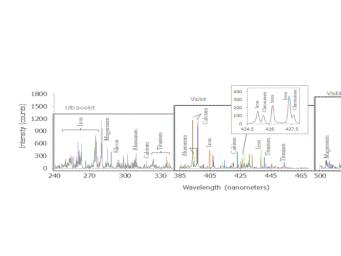
|
ChemCam Spectrum from Martian Rock Target ‘Ithaca’
- Click the image above for a larger view
- Full-Res JPEG (960 x 720) (56.6 kB)
- Full-Res TIFF (960 x 720) (2.1 MB)
Caption:
This graph shows a spectrum recorded by the Chemistry and Camera instrument (ChemCam) in NASA's Curiosity Mars rover. The instrument measured intensity of light at 6,144 wavelengths of ultraviolet, visible and infrared light emitted when it fired its laser at a rock target called "Ithaca." This spectrum averages data from multiple laser firings at the same point on the rock, the lowest point in a series of targeted points on the same rock examined on Oct. 30, 2013. The firings at this particular point included the 100,000th laser shot by Curiosity on Mars.
The spectrum is typical of Martian volcanic (basalt) material. Although Ithaca is a sedimentary rock, the particles in the sediments that became the rock originated in igneous source rocks. The elements identified from the spectrum include a standard major-element suite of silicon, magnesium, aluminum, calcium, sodium, potassium, oxygen and titanium. Chromium and manganese, though not labelled, were also present.
Background Info:
NASA's Jet Propulsion Laboratory, Pasadena, Calif., manages the Mars Science Laboratory Project and the mission's Curiosity rover for NASA's Science Mission Directorate in Washington. The rover was designed and assembled at JPL, a division of the California Institute of Technology in Pasadena.
More information about Curiosity is online at http://www.nasa.gov/msl and http://mars.jpl.nasa.gov/msl/ .
Cataloging Keywords:
| Name | Value | Additional Values |
|---|---|---|
| Target | Mars | |
| System | ||
| Target Type | Planet | |
| Mission | Mars Science Laboratory (MSL) | |
| Instrument Host | Curiosity Rover | |
| Host Type | Rover | |
| Instrument | Chemistry & Camera (ChemCam) | |
| Detector | ||
| Extra Keywords | Color, Infrared, Ultraviolet, Volcano | |
| Acquisition Date | ||
| Release Date | 2013-12-05 | |
| Date in Caption | 2013-10-30 | |
| Image Credit | NASA/JPL-Caltech/LANL/CNES/IRAP/UNM | |
| Source | photojournal.jpl.nasa.gov/catalog/PIA17593 | |
| Identifier | PIA17593 | |
